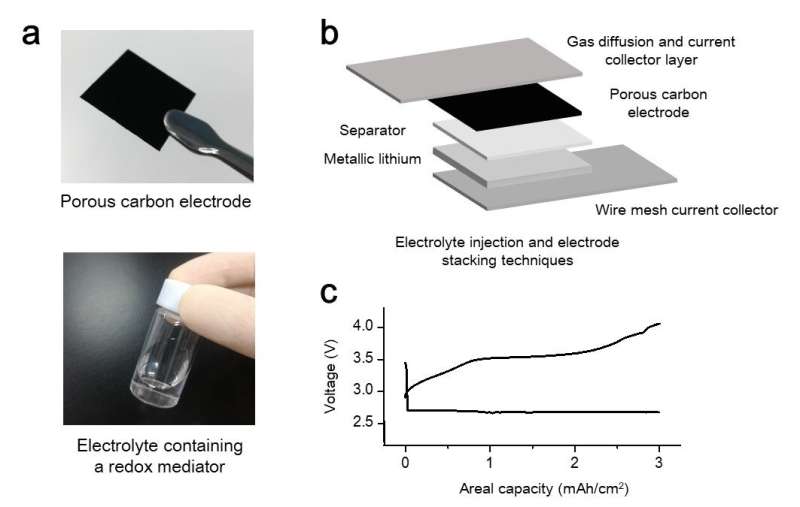Team develops lithium-air battery with an energy density higher than current lithium ion batteries

NIMS and Softbank Corp. have developed a lithium-air battery with an energy density over 500Wh/kg—significantly higher than that of current lithium ion batteries. The research team then confirmed that this battery can be charged and discharged at room temperature. In addition, the team found that the battery developed by the team shows the highest energy densities and best cycle life performances ever achieved. These results signify a major step toward the practical use of lithium-air batteries.
Lithium-air batteries have the potential to be the ultimate rechargeable batteries: They are lightweight and high-capacity, with theoretical energy densities several times that of currently available lithium ion batteries. Because of these potential advantages, they may find use in a wide range of technologies, such as drones, electric vehicles and household electricity storage systems.
NIMS has been carrying out basic research on lithium-air batteries with support from the ALCA-SPRING program (ALCA: Advanced Low Carbon Technology Research and Development Program, SPRING: Specially Promoted Research for Innovative Next Generation Batteries). This program has been funded by the Japan Science and Technology Agency (JST) with the goal of accelerating large-capacity rechargeable battery R&D. In 2018, NIMS and Softbank co-founded the Advanced Technologies Development Center to conduct research with the goal of putting lithium-air batteries into practical use in mobile phone base stations, the Internet of Things (IoT), HAPS (high altitude platform stations) and other technologies. Despite their very high theoretical energy densities, only a small number of lithium-air batteries with high energy densities have actually been fabricated and evaluated. This limited success is attributed to the fact that a large proportion by weight of lithium-air battery contains heavy inactive components (e.g., separators and electrolytes) that do not directly participate in actual battery reactions.
This research team had previously developed original battery materials that significantly increase the performance of lithium-air batteries in ALCA-SPRING-supported research. The team then developed a technique to fabricate high-energy-density lithium-air cells at the NIMS-SoftBank Advanced Technologies Development Center. Finally, they created a new lithium-air battery by combining these new materials and the fabrication techniques. The developed battery exhibited the energy density over 500 Wh/kg—substantially higher than that of currently available lithium ion batteries. Notably, the repeated discharge and charge reaction proceeds at room temperature. The energy density and cycle life performance of this battery are among the highest ever achieved, based on surveys conducted by NIMS (as of December 14, 2021)
The team is currently developing higher-performance battery materials and plans to integrate them into the newly developed lithium-air battery with the aim of greatly increasing the battery’s cycle life. The team then plans to expedite efforts to put the battery into practical use at the NIMS-SoftBank Advanced Technologies Development Center.
This project was carried out by a research team led by Shoichi Matsuda (Senior Researcher, NIMS), Manai Ono (Postdoctoral Researcher, NIMS), Shoji Yamaguchi (Specialist Staff, NIMS) and Kohei Uosaki (Research Fellow, NIMS; also Director, NIMS-SoftBank Advanced Technologies Development Center).
Identification of a major factor influencing the cycle life of high energy density lithium-air batteries
Shoichi Matsuda et al, Criteria for evaluating lithium–air batteries in academia to correctly predict their practical performance in industry, Materials Horizons (2021). DOI: 10.1039/d1mh01546j
Citation:
Team develops lithium-air battery with an energy density higher than current lithium ion batteries (2022, January 20)
retrieved 20 January 2022
from https://techxplore.com/news/2022-01-team-lithium-air-battery-energy-density.html
This document is subject to copyright. Apart from any fair dealing for the purpose of private study or research, no
part may be reproduced without the written permission. The content is provided for information purposes only.
For all the latest Technology News Click Here
For the latest news and updates, follow us on Google News.

